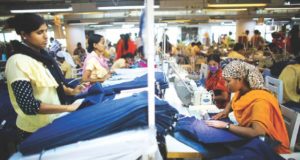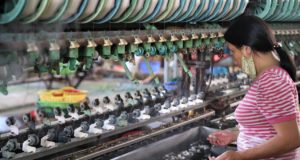By Wu Yabin
Published in The Global Times on January 16, 2018

Partly because it is such a massive global industry, the textile trade is closely linked to a number of development issues such as employment and labor, and also the promotion of clean technologies.
From the perspective of manufacturers, promoting green value chains means that the concept of sustainability and greenness should be embodied in the whole production process. This requires not only an assessment of products’ environmental impact at the beginning of the design stage, but also a focus on the application of environmental protection technologies and cleaner production processes.
Manufacturers should actively adopt sustainable standards and requirements for cleaner production in order to effectively control the use of harmful chemicals. From the perspective of the government, it should actively provide enterprises with policy guidance and necessary financial support while making full use of market instruments to finance sustainable production and green value chains.
It should also promote the formation of green standards in the textile industry.
Chinese companies should be encouraged to go abroad and learn from the experiences other countries have had. Actively carrying out international cooperation can enhance the building of green value chains.
In 2016, China’s Ministry of Industry and Information Technology released the “Development Plan for the Textile Industry (2016-20),” including an explicit proposal to promote smart manufacturing and green manufacturing in the textile industry and form new momentum for development in order to push China’s textile industry toward the middle and high end of the value chain.
During the 13th Five-Year Plan (2016-20) period, China will make further efforts toward the goal of green development, establish a green manufacturing system for the textile industry and promote the widespread application of cleaner production technologies.
By 2020, China’s textile industry is expected to have cut energy consumption per unit of industrial added value by 18 percent, with a cut in water intake per unit of industrial added value of 23 percent and a reduction of 10 percent in the total discharge of major pollutants.
In addition to breakthroughs in a number of key generic technologies for the recycling of used textiles, the proportion of the textile fiber recycling volume in total fiber processing volume is also expected to be continuously increased.
From a global perspective, the pattern of the textile industry will be further adjusted. Although China has comprehensive and competitive advantages in the global value chain, it is facing increasing pressure from international competition. The country faces an urgent task of structural adjustment and industrial upgrading, and must also deal with a “double squeeze” between developed countries’ re-industrialization and developing countries’ accelerated industrialization. The manufacturing capabilities of developed countries will continue to grow in the fields of high-end equipment, high-performance fibers and smart textiles and garments because of their obvious advantages in research, branding and sales channels.
Developing countries in Asia and Africa, meanwhile, have obvious advantages in terms of cost of labor, and some of them such as India, Vietnam, Bangladesh and Pakistan have shown clear upward trends in terms of textile industry development.
In November 2016, the Guiding Opinions on Strengthening International Cooperation to Upgrade China’s Industry in the global value chain was jointly promulgated by government branches including the Ministry of Commerce and the National Development and Reform Commission.
On the basis of this policy document, China will improve its ability to allocate resources by deepening its cooperation in the global value chain, attracting premium global resources, and enhancing the contribution of domestic added value through the combination of manufacturing and services.
The author is executive dean of the Research Institute for Global Value Chains at the University of International Business and Economics. bizopinion@globaltimes.com.cn
 CPD RMG Study Stitching a better future for Bangladesh
CPD RMG Study Stitching a better future for Bangladesh



